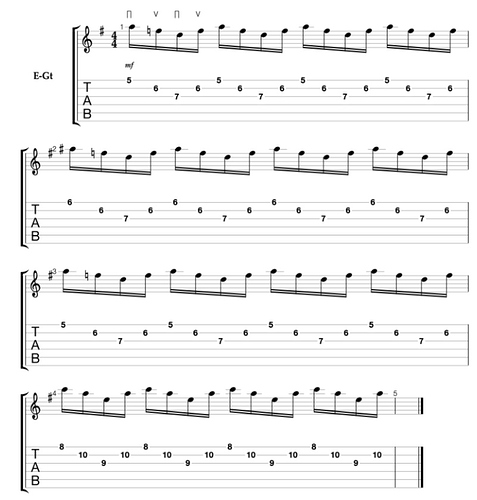The “caliber” of player isn’t really the issue here - it’s the kind of pickstroke the player knows how to make. As an example, I would imagine lots of people would rate Eric Johnson as high you can rate a player - I mean, the live performance on “Austin City Limits” is an all-time great. But Eric doesn’t do a double-escape pickstroke, so he doesn’t play alternate-picked arpeggio lines. In fact there’s a whole scene on both of his instructional videos where he talks about trying to figure it out. He doesn’t explain things quite to that level of detail, but he says something about wanting downstrokes to move the same way his upstrokes move. And looking back in hindsight at the motion he mimes in the air, it seems likely this is what he was getting at.
What, then, do we make of these instances where you have a player that can do something in the studio but there is no or very little evidence of them ever doing it live? Well, one thing we might be seeing in such cases is a player who is partway through figuring out the technique but hasn’t quite figured it out yet to where they have it all the time. This is super common when you’re learning — the flip flopping between “oh, I got it”, and “damn it’s not working today”. It can feel random in the early stages.
If you’re a bluegrass player you grow up playing roll patterns like this all day long - it is your default. By the time your technique is mature, you can do it as confidently as any of the shred heroes can play a three-note-per-string scale. There’s no reason for it to flip-flop because the motion is learned. Statistically, the batting average is high and will generally tend to stay that way.
So I think when it comes to these great players like Ritchie, you have to see the glass half full. These players had no slow-motion video to look at, and yet here they are essentially discovering techniques by feel — techniques which they did not grow up habitually playing because it wasn’t as common in their style of music.
Btw I will apologize again for the confusion of the term “crosspicking”. Moving forward, I think it’s much clearer to think about the kind of pickstroke needed to play certain phrases. A 1nps alternate-picked arpeggio always requires a double-escape picking motion, because you want to avoid the surrounding strings. Whether or not you call this “crosspicking” is up to you. But without a doubt, if you want to alternate pick a roll pattern, the double escape is the motion you’ll need.
We covered this exact picking pattern in our second lesson on double escape picking motions. Here are a couple takes of it:
In these clips I’m using a combination of wrist and forearm. But any picking motion that can perform a double escape pickstroke can be used to play this pattern, including just the wrist by itself, the elbow plus the wrist, as well as various combinations of wrist, forearm, and fingers like what Martin Miller does.
We’re working on some updates to the Pickslanting Primer now to lay this out a little more clearly. Again, sorry for the confusion in the mean time.


 Definitely pure alternate picking.
Definitely pure alternate picking.